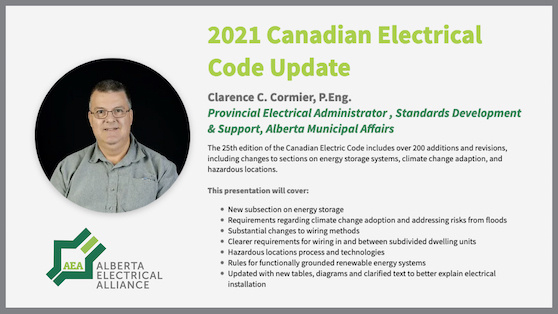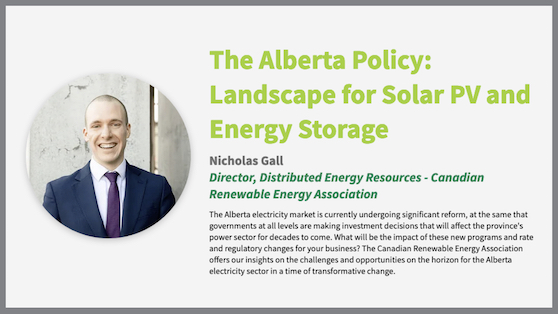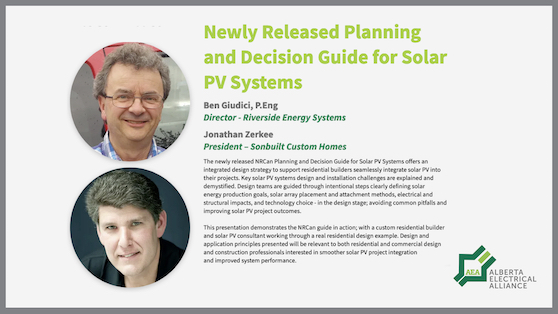
Articles
Features
Articles
Blog
Alberta’s 2021 economic outlook, renewables and more
November 26, 2020 | By Anthony Capkun
Lessons learned from the Alberta Electrical Alliance’s 2020 Electrical Learning Expo

November 26, 2020 – If I’m not tired at the end of a day of seminars and tradeshow, then I must not have done it right. However, I can tell you that at the end of the Alberta Electrical Alliance’s 2-day Learning Expo, I was exhausted.
You will recall that, like everyone else, AEA was forced to reschedule its 2020 Learning Expo due to pandemic. Typically held in March, the expo was initially rescheduled to October, but AEA saw the writing on the wall.
Rather than cancel the event outright, or reschedule again, they forged ahead and offered the 2020 Learning Expo online.
As I mentioned in my Editor Note from the October 2020 edition of Electrical Business Magazine, “while these [virtual] events can never achieve the same level of connection, they are great for expanding your knowledge and giving you the edge”.
And the AEA Learning Expo did not fail in this regard. Like the in-person event, the expo consisted of an education track and exhibit hall, and I tried to cover them both.
For a quick recap of things that caught my eye on the tradeshow floor, have a look at my short little video.
Meantime, what follows are some of the things I learned from the education sessions which, now, I will pass on to you.

Alberta’s evolving economy
Todd Hirsch, vice-president & chief economist with ATB Financial, painted a pretty bleak picture regarding Alberta’s economic outlook but, to his credit, he tried concluding on an optimistic note.
ATB issues economic outlooks quarterly but, when the pandemic took hold in March, “we threw it out”, knowing their latest outlook would be meaningless because “things were changing too rapidly”. They held off producing an outlook until last month, October 2020.
Alberta’s 2020 GDP will contract to the tune of -7.1%. This is a bigger hit than the financial crisis of 2009, and bigger than Alberta’s recession of 2015 and 2016 combined, Todd said.
A rebound of 3.3% is expected in 2021, but this forecast assumes a lifting of restrictions, and no third wave of Covid. It is also contingent on oil prices “firming up a bit”, around the $40/$45 per barrel mark. But this rebound still doesn’t get the province out of the hole, which may not come until 2023.
The unemployment rate for 2020 is at 11.4%, and is expected to remain around 11% for 2021. However, the real unemployment figure is likely larger—somewhere around 20%—because the official figures do not account for people who are still working, but perhaps with reduced hours, or people who are discouraged… that is, they’ve given up because they have no prospects, and will wait until conditions improve.
So “the job market is going to be tough the next little while in Alberta,” Todd said.
“2014 was a great year for Alberta, but we’ve since learned we were too dependent on one economic engine; specifically, crude oil,” Todd noted. “It’s now more of a backbone.”
However, three sectors continue to perform well, and are expected to grow:
1. Tech & Digital: This sector is tough to pinpoint, because government does not see this as a sector, per se, in their statistics. This industry will continue to expand and attract but, Todd noted, the jobs aren’t as high-paying as the energy sector.
2. Agriculture: This sector has been a backbone industry since before energy, with 70% of current output coming from three products: wheat, canola, and cattle. And 2020 was a great year for Alberta’s farmers. The other 30% of output has great potential. It includes potatoes, cannabis, vegetables, etc., as well as food processing, which includes everything from craft brewing to honey.
3. Renewable Energies & Cleantech: This includes lesser-known renewables, like geothermal. “Our geothermal resources are harder to get at—we don’t have volcanoes, like Iceland—but who better in the world to dig down two kilometres to get at them than Albertans?” Cleantech excites Todd, especially as it pertains to oil & gas extraction i.e. carbon capture. “The business community does not see these things as penalties, but as opportunities,” he said.
“We are amazingly adaptable when we need to be,” Todd reminded us, and he brought up the energy crisis of 1973-74. During this period, the United Kingdom faced—not only the crisis—but a strike by coal miners. Among other measures, the government mandated a 3-day work week (from January 1 to March 6, 1974) to save energy.
“You would expect the economy to drop by roughly 50%, but the economy only dropped 10%,” Todd pointed out. “Workers adapted to become more efficient with the time they had.”

CE Code 2021 Update
Clarence Cormier, provincial electrical administrator, provided a detailed overview of the all changes that we’re likely to see in the 2021 Canadian Electrical Code, C22.1:21 “Safety standard for electrical installations”.
In Alberta, the code falls under the jurisdiction of the Safety Code Act and, barring any changes from Municipal Affairs, the 2021 CE Code-Part I comes into effect in that province a year later—February 1, 2022.
(Clarence reminded us that Part I starts at the consumer’s side of the demarcation point between them and the supply authority. Electric utilities in the province are governed by the Alberta Electrical Utility Code.)
Final public commentary on the 2021 code will be over soon, then it will be published in January 2021. There are many changes to the 2021 version… I had trouble keeping up with Clarence. Suffice to say, you should buy the new code when it publishes It’s also a good idea to sign up for code update webinars and courses when they become available.
Clarence did point out that when you think has gone “missing” from the code, it does not necessarily mean it has been removed. It may have simply been moved to another Section.

Alberta’s solar landscape and LEEP planning guide
Solar PV figured prominently during the Learning Expo, starting with Nicholas Gall of the Canadian Renewable Energy Association, who pointed out that Southern Alberta (and Saskatchewan) has a world-class solar PV resource.
Alberta, however, is very appealing to renewables investors because it is completely deregulated, Nicholas said, with a transparent, competitive process for generation. (Ontario is “not completely” deregulated, he added, or presents “too many barriers” for market entry.)
As such, he thinks Alberta is well-poised to take advantage of market-driven renewables (not policy-driven, like Ontario), not to mention that the retail price of solar PV per watt has dropped some 90% since 2008.
When I asked Nicholas where Alberta’s electrical contractors can find opportunity in renewables, he pointed to behind-the-meter, microgen—even energy storage—applications.

Ben Giudici of Riverside Energy Systems and Jonathan Zerkee, president of Sonbuilt Custom Homes, discussed the “LEEP planning guide for solar PV systems” which outlines a “Procedure for solar designers, builders and their design teams to quickly define solar PV requirements”.
“LEEP” stands for “Local energy efficiency partnerships”. The purpose behind this guide—which Ben helped develop—is to help solar PV consultants and installation contractors—along with homebuilders and their clients—integrate solar PV technologies into residential applications.
The LEEP guide follows a logical path of 10 Steps for getting solar PV right the first time. Ultimately, the most-important rule is to plan for solar PV at the outset, not as as afterthought.
For their presentation, Ben and Jonathan played the roles of consultant and homebuilder (so they played themselves, actually) and re-enacted the step-by-step approach they took for an actual home Jonathan was constructing: Lot 6 in Sonbuilt’s Vine development.
“Our initial goal was to integrate solar and make the house net zero,” said Jonathan.
Then he and Ben started going through the 10 Steps of the LEEP Guide, especially Appendix B, “Solar PV System Integration Worksheet”. The cost to build the home was $650,000; to make it “net zero-ready” (not completely net zero… more on that below) it required an additional $8000.
Jonathan removed south-facing dormer from his design, and that bought him great real estate for the solar PV system. In fact, the money he saved on the dormer pretty much paid for the solar, he says.
As they worked through the guide, they tackled concerns like utility connection requirements, design requirements, array location, electrical and structural impacts, etc.
Ben reminded us to review and ensure we followed CE Code-Part I, Section 64, “Renewable energy systems”, especially regarding bus capacity requirements.
As for the roof’s structural capacity, it is a simple matter of informing your truss supplier about the PV system, and buying reinforced trusses, Jonathan said. The added cost is negligible.
Still following the LEEP guide, they determined appropriate attachment methods for the system, the desired solar panel, and inverter (e.g. string, micro, bi-modal). “Aesthetically, I wanted customers to see the solar PV system, but still have it blend in, so I chose Mono-Si All-Black,” Jonathan said.
The final step in the guide is determining your energy monitoring approach.
Earlier on, Ben and Jonathan determined the solar array’s production target. Lot 6’s projected production is 3.1 kW, or about 35% to 37% of home’s annual expected load. “After the home is sold and occupied, we will be able to gather real-world data” to see how actual production compares with projected production, Jonathan added.
In the end, Lot 6 achieved a final status of “Net zero-ready, PV-equipped”. The East and West elevations have been wired to accommodate additional solar PV, should the homeowner wish to add more.
With regard to the pursuit of net zero, Ben said “It does not have to be a case of all or nothing”.
The “LEEP planning guide for solar PV systems” is free, and can be downloaded here from NRCan (PDF download).

UV-C lighting: what’s here, and what isn’t… yet
Ben Rajewski, Electrical team lead with Williams Engineering Canada, discussed UV-C lighting’s applications for disinfection.
There are several types of UV-C light sources, including low-pressure mercury (the most common), pulsed xenon (short life, produces ozone) and UV-C LEDs (tunable, with instant On/Off).
The UV-C technology that most excites Rajewski, however, is something called Far UV-C. He admits, research is still being done, but the technology is very promising because it will deactivate bacteria and viruses but not penetrate human eyes or skin. If it can be proven safe, Rajewski thinks it will become a standard for new construction.
While some may argue that a UV-C light source in an air-handling unit is all you need, Rajewski pointed out that, Yes, they do reduce the number of infections within a building, but they do not help people who are located in the same room (same with HEPA filters).
Hence the case for ceiling-mount UV-C solutions to treat the air in the room, which have been shown to be highly effective at cleaning the air of droplets.
Surface cleaning (i.e. a ceiling fixtures that beams UV-C down to surfaces) is not currently approved for use in Canada. Strict safety controls must be in place to prevent accidental exposure, plus these solutions only disinfect what they can “see”. So they won’t clean under desks, for example.
(SEE ALSO our webinar UV-C Disinfection for Air & Surfaces.)
Let the learning continue
Hopefully you’ve not only found this recap informative, but are encouraged to explore additional opportunities to further your knowledge and expand your horizons… even if they’re only available online.
Like Todd said: We are amazingly adaptable when we need to be.
Thanks again for having me, Tara Ternes… well done to you and the Alberta Electrical Alliance team.
An abbreviated version of this article—along with other great content—appears in the February 2021 edition of Electrical Business Magazine. Even more back issues are located in our Digital Archive.
Print this page